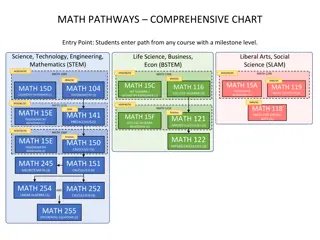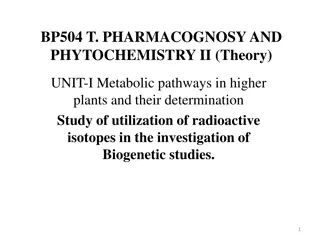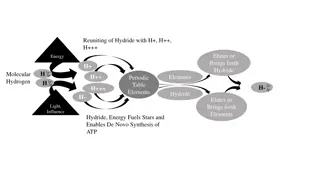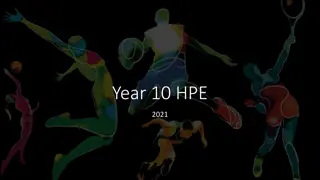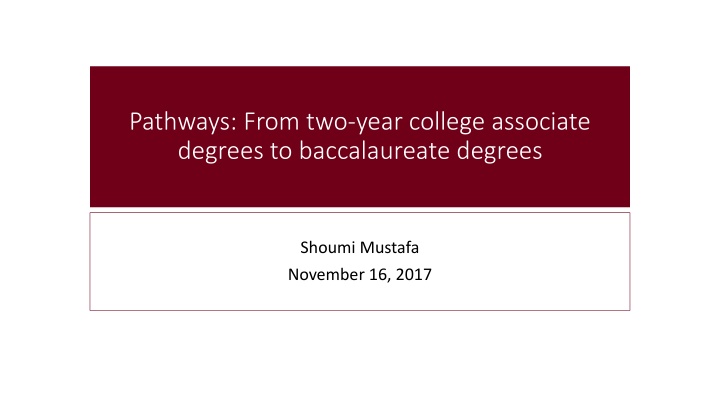
Developing Efficient Pathways from Associate to Baccalaureate Degrees
Explore the pathways from two-year college associate degrees to baccalaureate degrees, focusing on Ohio's public two-year institutions. Discover the differences in enrollment and graduation rates between Applied/Technical and Arts/Science associate degrees. Gain insights into transitioning from associate to baccalaureate degrees, and understand the importance of efficient course mappings for various baccalaureate disciplines.
Download Presentation

Please find below an Image/Link to download the presentation.
The content on the website is provided AS IS for your information and personal use only. It may not be sold, licensed, or shared on other websites without obtaining consent from the author. If you encounter any issues during the download, it is possible that the publisher has removed the file from their server.
You are allowed to download the files provided on this website for personal or commercial use, subject to the condition that they are used lawfully. All files are the property of their respective owners.
The content on the website is provided AS IS for your information and personal use only. It may not be sold, licensed, or shared on other websites without obtaining consent from the author.
E N D
Presentation Transcript
Pathways: From two-year college associate degrees to baccalaureate degrees Shoumi Mustafa November 16, 2017
Developing pathways: Questions & answers Information: Mapping the pathways Answers from the data Almost 15,000 associate degrees granted by public two-year colleges in 2009-10. How many associate degrees are granted by Ohio s public two-year institutions? How many of the associate degrees are Applied/Technical and how many are in Arts/Science? Do four-year college enrollment rates differ by associate degree types? 11,641 77.8% of all associate degrees are Applied/Technical degrees. Yes. Enrollment rates are 22.1% for Applied/Tech. & 48.8% for Arts/Science. Graduation rates also differ; 50.8% for Applied/Tech. & 70.1% for Arts/Science. What about graduation rates? Do baccalaureate degree types (for a given discipline) differ by associate degree types? Baccalaureate degree types appear not to differ by associate degree types. 2
From associate to baccalaureate degrees Associate degrees granted by Ohio public two-year institutions fall in two broad categories: Applied & Technical: Associate of Applied Business (AAB); Associate of Applied Science (AAS); Associate of Technical Studies (ATS) & Associate of Information Technology (AIT). Arts & Sciences Associate of Arts (AA) & Associate of Science (AS). Depending on the associate degree type and the pathways students choose, they have varied options leading to baccalaureate degrees. The required combination of courses in four-year institutions depend on the following: Type of associate degree & area of concentration Preferred baccalaureate degree discipline 3
Information for developing pathways An efficient system eliminates course duplication, and ensures that credits accumulated under associate degrees apply to meeting baccalaureate degree requirements. In order to develop efficient pathways, we need mappings of pathways for each prominent baccalaureate degree discipline; we need information on the following: Associate degree types + Associate degree area concentrations Subsequent four-year institution enrollment patterns Baccalaureate degree receipt Baccalaureate degree discipline Baccalaureate degree names and degree granting institutions This report considers pathways leading to baccalaureate degrees in business. A series of similar reports would be prepared for other disciplines. Next: Human Services/Social Work. 4
Progression parameters: All associate degree recipients Associate degree types Subsequent four-year institution enrollment patterns Baccalaureate degree receipt Information presented in this report are obtained using data from the Higher Education Information (HEI) system of the Ohio Department of Higher Education. 5
Two-year college associate degrees in 2009-10: Distribution of degree type All Associate Degrees* N: 14,861 Arts/Science Degrees: Applied/Technical Degrees N:3,220 N: 11,641 (21.5%) (77.8%) AS: AA: AA & AS: ATS: AAB: AAS: N:960 N:2,157 N:103 N:344 N:2,480 N:8,817 AAB: Associate of Applied Business; AAS: Associate of Applied Science; ATS: Associate of Technical Studies; AA: Associate of Arts; AS: Associate of Science. *An additional 73 individuals had received both Applied/Technical & Arts/Science degrees, and another 33 had received Associate degrees in Individual Studies. Those 106 students are excluded from the chart. 6
Progression from associate to baccalaureate degrees: All associate degree recipients All Associate Degrees N: 14,861 Arts/Science Degrees: Applied/Technical Degrees N:3,220 (22.2%) N: 11,641 (77.8%) Four-year enrollment: Four-year enrollment: 1,569 (48.8%) 2,575 (22.1%) Graduation: Graduation: 1,304 (50.8%) 1,100 (70.1%) Note: Four-year enrollment refers to attendance at Ohio public four-year main and regional campuses. 7
Distribution of Baccalaureate degree disciplines: All associate degree recipients Chart 1. Distribution of Baccalaureate Degree Disciplines: For All Associate Degree Recipients 30.0% 27.8% 25.0% N=670 20.0% 16.1% 15.0% 14.6% N=389 11.2% N=353 N=270 10.5% 10.0% 9.3% N=254 N=223 5.2% 5.0% 5.0% N=120 N=5 N=126 Total number of baccalaureate Degrees: N=2,410 0.5% 0.0% Social & Behavioral Sciences Natural Science & Mathematics Arts & Humanities Business Education Engineering Health Law Services All 11.2% 14.6% 5.2% 9.3% 27.8% 0.5% 10.5% 5.0% 16.1% 8
Moving to specific pathways: Business Questions What associate degree types usually lead to baccalaureate degrees in business? Do baccalaureate degree disciplines differ between associate degree recipients with and without area concentration in business, respectively? Do baccalaureate degree disciplines differ among associate degree recipients with business concentration? We focus on Applied/Technical and Arts/Science degree comparisons. Do individual four-year institutions grant different types of baccalaureate in business degrees to Associate of Applied/Technical and Arts/Science degree recipients? 9
Classification of associate degree types: Business In mapping the pathways from associate degree types to baccalaureate degrees in business, we combine the associate degrees to obtain the following classifications. 1. Associate of Applied Business 2. Combined group: (Associate of Applied Science + Associate of Technical Studies) Business concentration 3. Combined group: (Associate of Applied Science + Associate of Technical Studies) Non- Business concentration 4. Combined group: (Associate of Arts + Associate of Science) Business concentration 5. Combined group: (Associate of Arts + Associate of Science) Non-Business concentration Note: The following subjects are classified as parts of the Business Discipline by the Higher Education Information System (HEI) of the Ohio Department of Higher Education: Accounting, Administrative and Secretarial, Business - Other, Computer and Quantitative Business Fields, Finance, General Sales, Merchandising and Related Markets, Human Resources Management and Labor Studies, Logistics, Management, Marketing, and Service Business.. 10
Progression from associate to baccalaureate degrees: Classifications for the business pathway Associate of Applied Science + Technical Studies: Concentration: Business Associate of Applied Science + Technical Studies: Concentration: Non-Business Associate of Arts + Science: Concentration: Business Associate of Arts + Science: Concentration: Non-Business Associate of Applied Business Number of degree recipients 2,480 485 8,676 124 3,096 Enrolled in Ohio public 4- year institutions 426 87 2,062 75 1,495 Rate of enrollment 17.2% 17.9% 23.8% 60.5% 48.3% Receivedbaccalaureate degrees 233 52 1,024 57 1,043 Rate of graduation (of enrolled individuals) 54.7% 59.8% 49.7% 76.0% 69.8% 11
Progression from associate to baccalaureate degrees: Classifications for the business pathway All Associate Degrees N: 14,861 AA + AS: Business Conc. N=124 AA + AS: AAS + ATS: Business Conc. N=485 AAS + ATS: Non-Business Conc. N=8,676 AAB Non-Business Conc. N=3,096 N=2,480 Enroll. Rate: Enroll. Rate: Enroll. Rate: Enroll. Rate: Enroll. Rate: 17.9% 23.8% 60.5% 48.3% 17.2% Grad. Rate: Grad. Rate: Grad. Rate: Grad. Rate: Grad. Rate: 54.7% 59.8% 49.7% 69.8% 76.0% AAB: Associate of Applied Business; AAS: Associate of Applied Science; ATS: Associate of Technical Studies; AA: Associate of Arts; AS: Associate of Science. 12
Distribution of baccalaureate degree disciplines: Classifications for the business pathway Associate of Applied Business Associate of Applied Science + Technical Studies: Concentration: Business Associate of Applied Science + Technical Studies: Concentration: Non-Business Associate of Arts + Science: Concentration: Business Associate of Arts + Science: Concentration: Non-Business 20 3 40 3 204 Arts & Humanities (8.6%) 126 (54.1%) 11 (4.7%) 6 (2.6%) 7 (3.0%) 34 (14.6%) 7 (3.0%) 20 (8.6%) (5.8%) 22 (42.3%) (3.9%) 23 (2.2%) 39 (3.8%) 137 (13.4%) 556 (54.2%) 74 (7.2%) 88 (8.6%) 67 (6.5%) (5.3%) 50 (87.7%) 1 (1.8%) 1 (1.8%) (19.6%) 132 (12.7%) 75 (7.2%) 79 (7.6%) 105 (10.1%) 130 (12.5%) 23 (2.2%) 293 (28.1%) Business Education - Engineering - 2 Health - (3.8%) 14 (26.9%) 2 (3.8%) 9 (17.3%) Natural Science & Mathematics 2 (3.5%) Services - Social & Behavioral Sci. - Total number of degrees 233 52 1,024 57 1043 Note: Five baccalaureate degrees in Law are not included in the table. 13
Distribution of baccalaureate degree disciplines: Associate of applied business degrees Chart 2. Distribution of Baccalaureate Degree Disciplines: For Associate of Applied Business Degree Recipients 60.0% 54.1% N=126 Number of Degrees in Natural Science & Mathematics: 34 Information Technology: 17 Information Science: 5 Computer System & Networks: 3 Computer Science & information Science: 2 Mathematics, General: 2 Mathematics & Computer Science: 1 50.0% 40.0% 30.0% 20.0% 14.6% Total number of baccalaureate degrees: N=233 N=34 8.6% 8.6% N=20 10.0% 4.7% N=20 3.0% 3.0% 2.6% 0.9% N=11 N=7 N=7 N=6 N=2 0.0% Natural Science & Mathematics Social & Behavioral Sciences Arts & Humanities Business Education Engineering Health Law Services Applied Business 8.6% 54.1% 4.7% 2.6% 3.0% 0.9% 14.6% 3.0% 8.6% 14
Distribution of baccalaureate degree disciplines: Associate of applied science & technical studies business concentration Chart 3. Distribution of Baccalaureate Degree Disciplines: For Associate of Applied Science & Technical Studies (Business Concentration) 45.0% 42.3% N=22 40.0% Number of Degrees in Natural Science & Mathematics: 14 Computer Science: 14 35.0% 30.0% 26.9% N=14 25.0% 20.0% 17.3% N=9 15.0% 10.0% Total number of baccalaureate degrees: N=52 5.8% 3.8% N=2 3.8% 5.0% N=3 N=2 0.0% 0.0% 0.0% 0.0% Natural Science & Mathematics Social & Behavioral Sciences Arts & Humanities Business Education Engineering Health Law Services AAS+ATS - Business 5.8% 42.3% 0.0% 0.0% 3.8% 0.0% 26.9% 3.8% 17.3% 15
Distribution of baccalaureate degree disciplines: Associate of applied science & technical studies Non-business concentration Chart 4. Distribution of Baccalaureate Degree Disciplines: For Associate of Applied Science & Technical Studies (Non-Business Concentration) 60.0% 54.2% N=556 50.0% Number of Degrees in Natural Science & Mathematics: 74 Computer Science: 49 Agricultural Science: 5 Biological Science: 6 Chemistry: 2 Forestry, Wildlife: 3 Geology & Hydrology: 1 40.0% 30.0% 20.0% 13.4% N=137 Total number of baccalaureate degrees: N=1,025 8.6% 7.2% 10.0% 6.5% N=88 3.9% 3.8% N=39 N=67 2.2% N=74 0.1% N=40 N=23 0.0% N=1 Natural Science & Mathematics Social & Behavioral Sciences Arts & Humanities Business Education Engineering Health Law Services AAS+ATS - Non-Business 3.9% 2.2% 3.8% 13.4% 54.2% 0.1% 7.2% 8.6% 6.5% 16
Distribution of baccalaureate degree disciplines: Associate of arts and science business concentration Chart 5. Distribution of Baccalaureate Degree Disciplines: For Associate of Arts & Science (Business Concentration) 100.0% 87.7% 90.0% N=50 80.0% 70.0% 60.0% 50.0% 40.0% 30.0% Total number of baccalaureate degrees: N=57 20.0% 5.3% N=3 10.0% 3.5% N=2 1.8% N=1 1.8% 0.0% 0.0% 0.0% 0.0% N=1 0.0% Natural Science & Mathematics Social & Behavioral Sciences Arts & Humanities Business Education Engineering Health Law Services AAR+ASC -Business 5.3% 87.7% 1.8% 1.8% 0.0% 0.0% 3.5% 0.0% 0.0% 17
Distribution of baccalaureate degree disciplines: Associate of arts and science Non-business concentration Chart 6. Distribution of Baccalaureate Degree Disciplines: For Associate of Arts & Science (Non-Business Concentration) 30.0% 28.1% N=293 25.0% 19.6% N=204 20.0% 15.0% 12.7% N=132 12.5% 10.1% N=130 10.0% N=105 7.6% 7.2% N=79 N=75 Total number of baccalaureate degrees: N=1,043 5.0% N=2 2.2% 0.2% N=23 0.0% Natural Science & Mathematics Social & Behavioral Sciences Arts & Humanities Business Education Engineering Health Law Services AAR+ASC Non-Business 19.6% 12.7% 7.2% 7.6% 10.1% 0.2% 12.5% 2.2% 28.1% 18
Baccalaureate degree names: Business Associate of Applied Science + Technical Studies: Concentration: Business Associate of Applied Science + Technical Studies: Concentration: Non-Business Associate of Arts + Science: Concentration: Business Associate of Arts + Science: Concentration: Non-Business Associate of Applied Business Baccalaureate degree names Number: 53 Number: 10 Number: 6 Number: 40 Number: 94 Bachelor of Science in Business Number: 203 CLEV:30;TLDO:8; OHSU:4;BGSU:4; AKRN:3;SHAW:2; WSUN:2 WSUN:27; BGSU:5; TLDO:5; OHSU:3 CLEV:51; OHSU:20; WSUN:16 WSUN:7;OHSU:2;TLDO:1 WSUN:3;OHSU:2;CLEV:1 Number: 50 Number: 3 Number: 4 Number: 6 Number: 8 Bachelor of Business Administration Number: 71 KENT:39; CINC:6; AKRN:2; CLEV:1; TLDO:1, OHUN:1 CINC:2;TLDO:1 KENT:3;CINC:1 CINC:6 KENT:7 Number: 10 Number: 5 Number: 11 Number: 2 Number: 21 Bachelor of Science Number: 49 OHUN:5;CINC:2; OHSU:2 WSUN:1; CNTL:1 WSUN:15;OHSU:4; AKRN:3 WSUN:3;OHUN:1CNTL:1 WSUN:10;CNTL:1 AKRN: University of Akron; BGSU: Bowling Green State University; CLEV: Cleveland State University; CNTL: Central State University; KENT: Kent State University; OHSU: Ohio State University; OHUN: Ohio University; SHAW: Shawnee State University; TLDO: University of Toledo; WSUN: Wright State University. 19
What did we learn? Large majorities of associate degrees granted by two-year institutions are Applied/Technical in nature. Of the 14,967 associate degrees granted in 2009-10 for example, 77.8% were Applied/Technical; Arts & Science degrees accounted 21.5%. In recent years, Applied/Technical shares have fallen to approximately 70.0%. The maximum number of baccalaureate in business degree recipients have Applied/Technical associate degrees Applied Business and Applied Science with business concentration, followed by Arts & Science degree recipients without business concentration. However, as a group, Arts and Science degree recipients with business concentration have the highest proportion of baccalaureate in business degrees. Finally, data do not suggest that Ohio s public four-year institutions treat Applied/Technical and Arts/Science associate degree recipients in a differential manner with respect to the type of baccalaureate degree granted in business. 20






